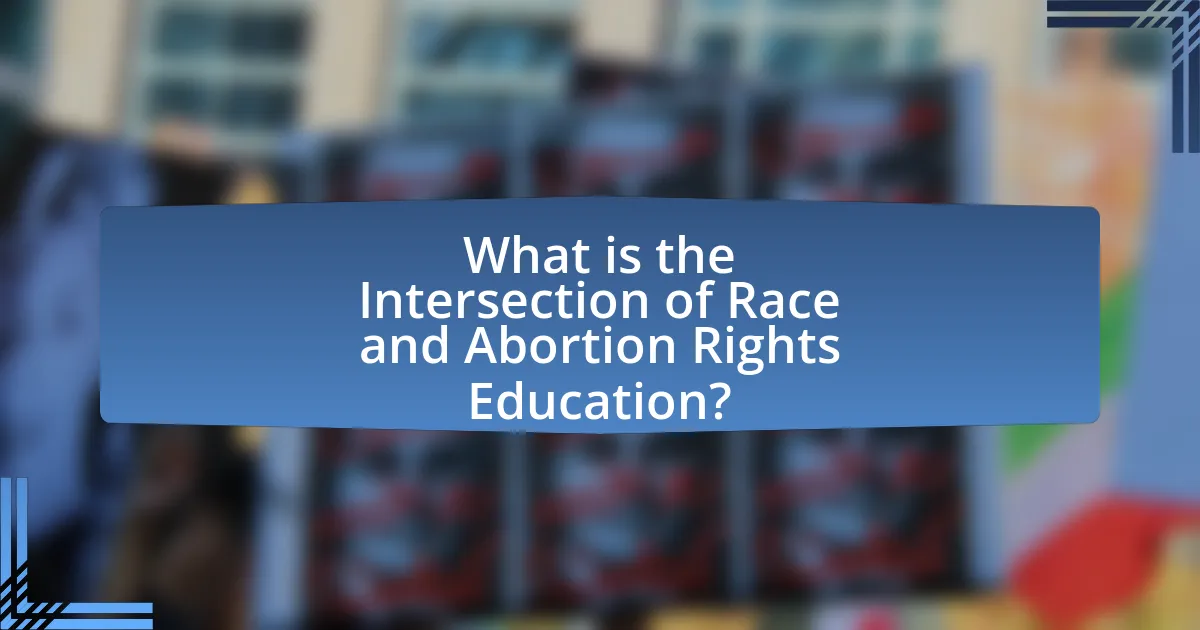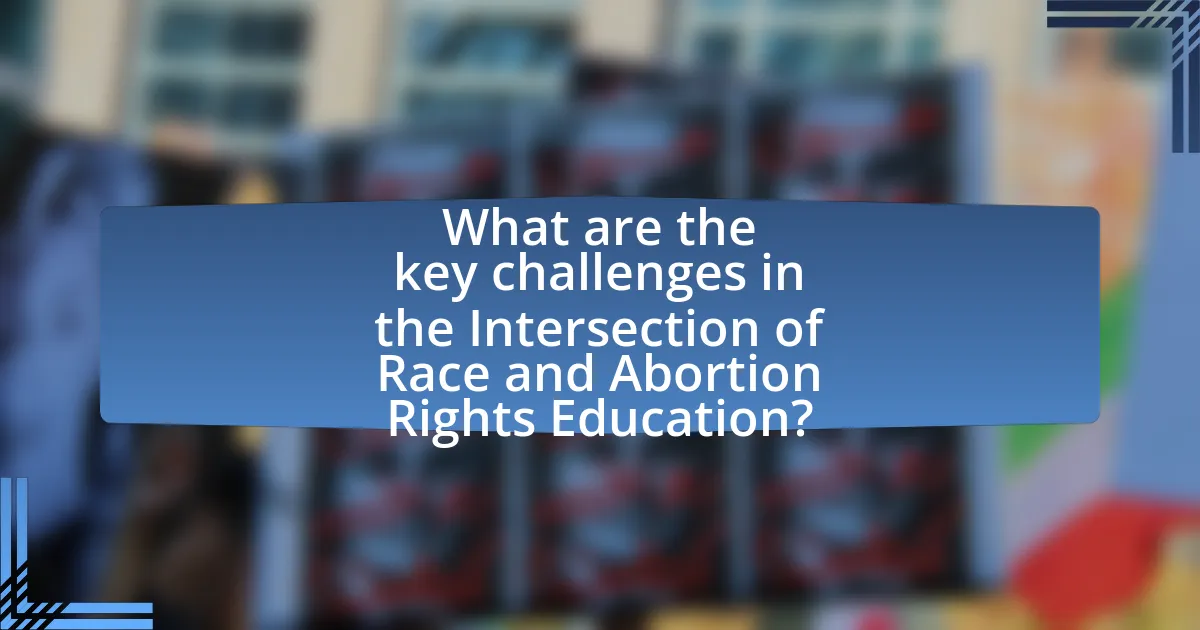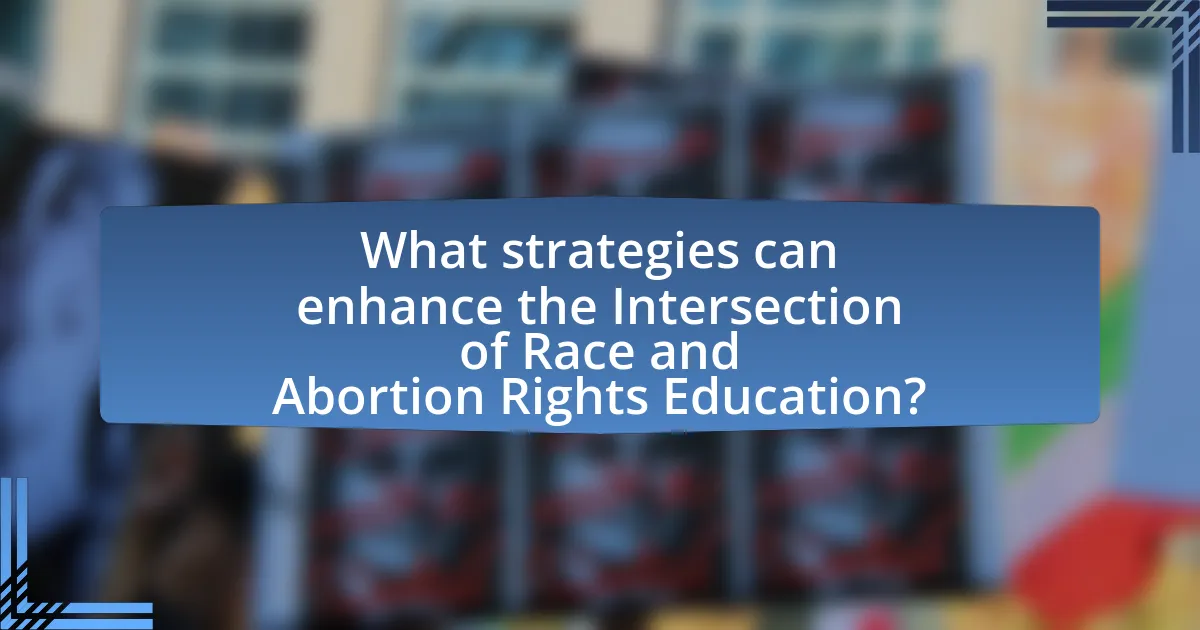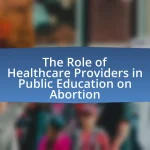The article examines the intersection of race and abortion rights education, highlighting how racial disparities affect access to abortion services and reproductive health education. It discusses systemic barriers faced by marginalized racial groups, particularly Black and Latina women, including socioeconomic challenges and misinformation. The article emphasizes the importance of culturally competent education and advocacy to address these disparities, improve access to reproductive healthcare, and promote equitable education on abortion rights. Additionally, it explores historical factors, cultural perceptions, and the impact of policy and legislation on the education surrounding abortion rights in diverse communities.

What is the Intersection of Race and Abortion Rights Education?
The intersection of race and abortion rights education refers to how racial disparities influence access to abortion services and the education surrounding reproductive rights. Research indicates that marginalized racial groups, particularly Black and Latina women, face systemic barriers such as socioeconomic challenges, lack of access to healthcare, and targeted misinformation about reproductive health. For instance, a study by the Guttmacher Institute highlights that Black women are more likely to experience unintended pregnancies and have less access to abortion services compared to their white counterparts. This intersection emphasizes the need for culturally competent education and advocacy that addresses these disparities to ensure equitable access to reproductive healthcare for all racial groups.
How do race and abortion rights intersect in educational contexts?
Race and abortion rights intersect in educational contexts by highlighting disparities in access to reproductive health education and services among different racial groups. Research indicates that marginalized communities, particularly Black and Latina women, face systemic barriers that limit their access to comprehensive sexual education and reproductive healthcare, which can lead to higher rates of unintended pregnancies and abortions. For instance, a study by the Guttmacher Institute found that women of color are more likely to experience obstacles in accessing abortion services due to socioeconomic factors and geographic location, which are often influenced by historical and ongoing racial inequities. This intersection underscores the need for inclusive educational policies that address these disparities and promote equitable access to reproductive rights for all students.
What historical factors have shaped the relationship between race and abortion rights education?
The relationship between race and abortion rights education has been shaped by historical factors such as systemic racism, socio-economic disparities, and targeted reproductive policies. Systemic racism has historically marginalized communities of color, leading to limited access to comprehensive reproductive health education and services. For instance, the eugenics movement in the early 20th century disproportionately targeted women of color, promoting sterilization and restricting their reproductive choices. Additionally, socio-economic disparities have resulted in unequal access to healthcare resources, further complicating the education surrounding abortion rights for racial minorities. Policies like the Hyde Amendment, which restricts federal funding for abortions, have also had a disparate impact on women of color, reinforcing barriers to education and access. These factors collectively illustrate how historical contexts have influenced the intersection of race and abortion rights education.
How do cultural perceptions of race influence abortion rights education?
Cultural perceptions of race significantly influence abortion rights education by shaping the narratives and frameworks through which reproductive health is understood and discussed. For instance, marginalized racial groups often face unique barriers to accessing abortion services, which can be exacerbated by societal stereotypes and stigmas surrounding their reproductive choices. Research indicates that Black and Latina women are disproportionately affected by restrictive abortion laws, which can lead to a lack of comprehensive education on their rights and available services. Furthermore, cultural beliefs about race can affect the willingness of educators and healthcare providers to engage with these communities, often resulting in a gap in information dissemination and support. This dynamic underscores the importance of culturally competent education that acknowledges and addresses the specific needs and experiences of diverse racial groups in the context of abortion rights.
Why is it important to address race in abortion rights education?
Addressing race in abortion rights education is crucial because racial disparities significantly impact access to reproductive healthcare. Studies show that women of color, particularly Black and Latina women, face higher barriers to accessing abortion services due to systemic inequalities, including socioeconomic factors and healthcare discrimination. For instance, the Guttmacher Institute reports that Black women are more than three times as likely to experience unintended pregnancies compared to white women, highlighting the need for targeted education that considers these disparities. By incorporating race into abortion rights education, advocates can better address the unique challenges faced by marginalized communities, ensuring equitable access to reproductive health services for all individuals.
What impact does racial inequality have on access to abortion rights education?
Racial inequality significantly limits access to abortion rights education, particularly for marginalized communities. This limitation arises from systemic barriers such as socioeconomic disparities, lack of resources, and inadequate representation in educational materials. For instance, studies indicate that Black and Hispanic women are less likely to receive comprehensive reproductive health education compared to their white counterparts, which directly affects their understanding of abortion rights and available services. Additionally, organizations like the Guttmacher Institute report that these communities often face obstacles in accessing healthcare providers who can offer accurate information about abortion options, further exacerbating the knowledge gap.
How can understanding race improve the effectiveness of abortion rights education?
Understanding race can improve the effectiveness of abortion rights education by tailoring messages and strategies to address the unique cultural, social, and economic contexts of different racial groups. Research indicates that marginalized communities, particularly people of color, often face systemic barriers to accessing reproductive healthcare, including abortion services. For instance, a study by the Guttmacher Institute highlights that Black and Latina women are disproportionately affected by restrictive abortion laws and lack of access to healthcare resources. By incorporating an understanding of these disparities into educational efforts, advocates can create more relevant and impactful programs that resonate with diverse audiences, ultimately fostering greater awareness and support for abortion rights across racial lines.

What are the key challenges in the Intersection of Race and Abortion Rights Education?
Key challenges in the intersection of race and abortion rights education include systemic racism, socioeconomic disparities, and cultural stigmas. Systemic racism affects access to comprehensive reproductive health education and services, particularly for marginalized communities. For instance, Black and Latina women face higher rates of unintended pregnancies and limited access to abortion services due to historical and ongoing discrimination in healthcare systems. Socioeconomic disparities further complicate this issue, as lower-income individuals often lack the financial resources to obtain abortion care, exacerbating existing inequalities. Additionally, cultural stigmas surrounding abortion within various racial and ethnic communities can hinder open discussions and education about reproductive rights, leading to misinformation and reduced access to necessary resources. These factors collectively create significant barriers to effective abortion rights education and access for racially diverse populations.
What barriers do marginalized communities face in accessing abortion rights education?
Marginalized communities face significant barriers in accessing abortion rights education, primarily due to systemic inequalities, lack of resources, and cultural stigmas. These communities often experience limited access to healthcare services, which includes educational resources about abortion rights. For instance, studies indicate that low-income individuals and people of color are less likely to receive comprehensive sexual and reproductive health education, leading to misinformation and lack of awareness about their rights. Additionally, cultural stigmas surrounding abortion can deter individuals from seeking information or support, further isolating them from necessary resources. According to the Guttmacher Institute, marginalized groups are disproportionately affected by restrictive laws and policies that limit access to reproductive health services, exacerbating the challenges they face in obtaining accurate abortion rights education.
How do socioeconomic factors affect access to abortion rights education for different races?
Socioeconomic factors significantly affect access to abortion rights education across different races by creating disparities in resources, information dissemination, and support systems. For instance, individuals from lower socioeconomic backgrounds often lack access to comprehensive sexual education and healthcare services, which are crucial for understanding abortion rights. According to a study published by the Guttmacher Institute, marginalized communities, particularly Black and Hispanic populations, face higher barriers to accessing reproductive health information due to systemic inequalities and limited educational resources. This results in a lack of awareness about their rights and available services, further perpetuating racial disparities in reproductive health education.
What role does misinformation play in the education of abortion rights among racial minorities?
Misinformation significantly hinders the education of abortion rights among racial minorities by perpetuating myths and inaccuracies that shape perceptions and understanding. For instance, studies indicate that racial minorities often encounter misleading information regarding the safety and legality of abortion, which can lead to increased stigma and fear surrounding the procedure. According to a report by the Guttmacher Institute, misinformation can result in lower rates of access to reproductive health services among these communities, as individuals may rely on incorrect information when making health decisions. This cycle of misinformation not only affects individual choices but also contributes to broader disparities in reproductive health outcomes among racial minorities.
How do policy and legislation impact the intersection of race and abortion rights education?
Policy and legislation significantly influence the intersection of race and abortion rights education by shaping access to reproductive health services and educational resources. For instance, restrictive abortion laws often disproportionately affect women of color, who may face greater barriers to accessing care due to socioeconomic factors and systemic inequalities. Research from the Guttmacher Institute indicates that Black and Latina women are more likely to experience unintended pregnancies and have higher abortion rates compared to their white counterparts, largely due to disparities in healthcare access and education. Furthermore, legislation that mandates comprehensive sex education can improve awareness and understanding of reproductive rights among diverse racial groups, thereby empowering them to make informed decisions. Thus, the interplay of policy and legislation directly impacts the availability and quality of abortion rights education, particularly for marginalized communities.
What recent laws have influenced abortion rights education in racially diverse communities?
Recent laws such as the Women’s Health Protection Act and various state-level legislation have significantly influenced abortion rights education in racially diverse communities. The Women’s Health Protection Act, introduced in Congress, aims to safeguard access to abortion services nationwide, thereby impacting educational initiatives that inform communities about their reproductive rights. Additionally, state laws that either restrict or expand access to abortion services directly affect the availability of educational resources tailored to racially diverse populations, as these laws often dictate the content and scope of sex education programs. For example, states with comprehensive reproductive health education laws tend to provide more accurate information about abortion rights, which is crucial for empowering racially diverse communities to make informed decisions regarding their reproductive health.
How can advocacy efforts address disparities in abortion rights education?
Advocacy efforts can address disparities in abortion rights education by implementing targeted outreach programs that focus on marginalized communities. These programs can provide culturally relevant information and resources, ensuring that individuals from diverse racial and socioeconomic backgrounds have access to accurate and comprehensive education about abortion rights. For instance, studies have shown that communities of color often face systemic barriers to healthcare access, including misinformation about reproductive rights. By partnering with local organizations and utilizing community leaders, advocacy groups can effectively disseminate information and empower individuals to understand their rights. This approach not only raises awareness but also fosters a supportive environment where individuals feel confident in seeking the care they need.

What strategies can enhance the Intersection of Race and Abortion Rights Education?
Integrating culturally relevant curricula and community engagement initiatives can enhance the intersection of race and abortion rights education. Culturally relevant curricula ensure that educational materials reflect the diverse experiences and histories of various racial groups, which can foster a deeper understanding of how race impacts access to abortion services. For instance, studies show that Black women face higher rates of maternal mortality and barriers to reproductive healthcare, highlighting the need for tailored educational approaches that address these disparities. Additionally, community engagement initiatives, such as partnerships with local organizations and leaders, can facilitate open dialogues about race and reproductive rights, empowering marginalized communities to advocate for their needs. This approach not only raises awareness but also builds trust and encourages participation in reproductive health discussions.
How can educational programs be tailored to address racial disparities in abortion rights?
Educational programs can be tailored to address racial disparities in abortion rights by incorporating culturally relevant content, community engagement, and targeted outreach strategies. Culturally relevant content ensures that the information resonates with diverse racial and ethnic groups, acknowledging their unique experiences and challenges related to reproductive health. Community engagement involves collaborating with local organizations and leaders to create trust and facilitate open discussions about abortion rights, thereby increasing awareness and understanding. Targeted outreach strategies, such as workshops and informational sessions in underserved communities, can directly address the barriers these populations face, including access to healthcare and misinformation. Research indicates that educational interventions that are culturally tailored can significantly improve knowledge and attitudes towards reproductive health among marginalized groups, thereby reducing disparities in abortion access.
What best practices exist for creating inclusive abortion rights education materials?
Best practices for creating inclusive abortion rights education materials include using diverse voices and perspectives, ensuring accessibility, and employing culturally relevant language. Incorporating diverse voices ensures that the materials reflect the experiences of various racial and ethnic groups, which is crucial given the intersection of race and abortion rights. Accessibility involves providing materials in multiple languages and formats, catering to individuals with disabilities, and considering varying levels of literacy. Culturally relevant language acknowledges the specific cultural contexts and values of different communities, making the information more relatable and effective. Research indicates that inclusive educational approaches can significantly enhance understanding and engagement among marginalized groups, thereby promoting equitable access to abortion rights information.
How can community engagement improve the effectiveness of abortion rights education?
Community engagement can significantly enhance the effectiveness of abortion rights education by fostering trust and facilitating open dialogue within diverse communities. Engaging community members allows for the incorporation of local values, cultural contexts, and specific needs, which makes educational efforts more relevant and relatable. For instance, studies have shown that community-led initiatives, such as workshops and discussions, can lead to increased awareness and understanding of abortion rights, particularly in marginalized groups. According to a report by the Guttmacher Institute, community-based education programs have been linked to improved access to reproductive health services and greater advocacy for abortion rights, demonstrating that localized engagement can lead to more informed and empowered communities.
What resources are available for educators addressing race and abortion rights?
Educators addressing race and abortion rights can access a variety of resources, including organizations, curricula, and research publications. Notable organizations such as the Guttmacher Institute provide comprehensive data and analysis on reproductive rights, including the intersection of race and access to abortion services. Additionally, the Center for Reproductive Rights offers educational materials that highlight racial disparities in reproductive healthcare. Curricula developed by groups like Advocates for Youth focus on inclusive education regarding race and reproductive rights, equipping educators with tools to facilitate discussions. Research studies, such as “Reproductive Justice: An Introduction” by Loretta Ross and Rickie Solinger, provide foundational knowledge on the topic, emphasizing the importance of understanding race in the context of abortion rights. These resources collectively support educators in effectively addressing the complexities of race and abortion rights in their teaching.
What organizations provide support for abortion rights education in diverse communities?
Organizations that provide support for abortion rights education in diverse communities include Planned Parenthood, the National Abortion Federation, and the Center for Reproductive Rights. Planned Parenthood offers educational resources and outreach programs tailored to various cultural and ethnic communities, ensuring access to accurate information about reproductive health. The National Abortion Federation provides training and resources to healthcare providers, focusing on equitable access to abortion services across different demographics. The Center for Reproductive Rights advocates for reproductive rights globally, emphasizing the importance of education in marginalized communities to combat misinformation and promote informed decision-making. These organizations collectively work to enhance awareness and understanding of abortion rights within diverse populations.
How can educators access training on culturally competent abortion rights education?
Educators can access training on culturally competent abortion rights education through specialized workshops, online courses, and resources provided by organizations focused on reproductive health and social justice. For instance, organizations like the Guttmacher Institute and Planned Parenthood offer training programs that emphasize the intersection of race and reproductive rights, ensuring educators are equipped with the necessary knowledge and skills. These programs often include evidence-based practices and culturally relevant materials, which are essential for effective teaching in diverse communities.
What are the next steps for improving race and abortion rights education?
The next steps for improving race and abortion rights education include integrating comprehensive curricula that address both racial equity and reproductive rights in educational institutions. This approach ensures that students understand the historical context and current implications of these issues, fostering informed discussions. Research indicates that inclusive education can significantly enhance awareness and empathy among students, as seen in studies by the American Psychological Association, which highlight the benefits of diverse perspectives in learning environments. Additionally, training educators to effectively teach these subjects can further enhance the quality of education provided, ensuring that discussions are sensitive and informed by current social justice movements.
How can individuals advocate for better abortion rights education in their communities?
Individuals can advocate for better abortion rights education in their communities by organizing informational workshops and discussions that focus on the intersection of race and reproductive rights. These events can provide a platform for sharing accurate information, personal stories, and resources related to abortion rights, particularly highlighting how these issues disproportionately affect marginalized communities. Research indicates that comprehensive sex education and access to reproductive health services can significantly reduce unintended pregnancies and improve health outcomes, as seen in studies conducted by the Guttmacher Institute. By collaborating with local organizations, schools, and healthcare providers, individuals can create a network that promotes awareness and understanding of abortion rights, ensuring that education is inclusive and culturally sensitive.
What role can technology play in enhancing access to abortion rights education for all races?
Technology can significantly enhance access to abortion rights education for all races by providing diverse platforms for information dissemination and engagement. Digital tools such as websites, mobile applications, and social media enable the widespread sharing of educational resources, ensuring that individuals from various racial backgrounds can access accurate information about abortion rights. For instance, a study by the Guttmacher Institute found that online resources can reach underserved communities, bridging gaps in knowledge and access. Additionally, technology facilitates virtual support networks and telehealth services, which can be particularly beneficial for marginalized groups facing barriers to in-person education and healthcare.


